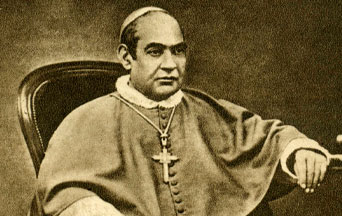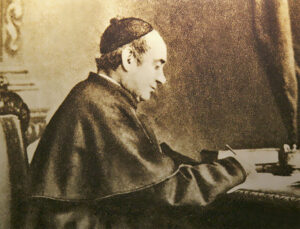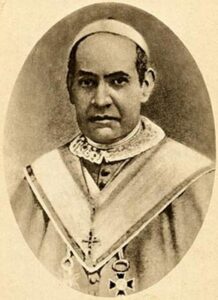
St. Anthony Mary Claret was a missionary archbishop, chaplain to royalty, founder and publisher. Anthony was born in 1807 to Juan and Josefa Claret and the family lived in the town of Sallent in the Catalonia region of Spain. Juan owned a textile/weaving business, and Anthony was the fifth of eleven children. From his childhood, he was devout and interested in the salvation of souls. He attended the local elementary school and told a bishop who visited the school that he wanted to be a priest.
SKILLED WEAVER
He learned to weave, and at age seventeen he went to Barcelona for special training for the making of jacquard cloth. He became adept at this skill and received job offers from large textile mills. He spent his free time studying engraving, French, and Latin. Disillusioned by the callousness of the business world, he enrolled in the diocesan seminary at Vic in 1829 and was ordained in 1835. He was first assigned to his home parish in Catalonia. He became known for his preaching missions, which began to attract large crowds. In 1842, Father Claret was given the title Apostolic Missionary by Pope Gregory XVI. Several years later, with a small group of priests, he founded Religious Press in order to reach people of all classes and locations.
APOSTOLIC MISSION
Spain in the mid-19th century was rocked by years of ongoing wars known as the Carlist Wars, and the fighting was most violent in northern Spain where Claret was laboring for souls. To help with the extensive injuries and illnesses, he learned some rudimentary medical practices. He gave several sermons each day, sometimes as many as twelve, and he travelled from place to place on foot. Believing that the Virgin Mary personally called him to preaching missions, he emphasized devotion to her and to the Blessed Sacrament. He was known to spend as many as ten hours per day hearing confessions, and many believed that he possessed the gift of reading consciences. In 1848, his life was in danger because of anti-Catholic forces, so he went to the Canary Islands, where he continued his mission preaching with success. His sermons were so well attended, he often had to deliver them outdoors. The following year, he returned to Spain and formed a new religious congregation, the Missionary Sons of the Immaculate Heart of Mary. He also established a vast religious library in Barcelona.
In 1849, Claret was assigned at age forty-two to be the bishop of Santiago de Cuba.
UNEXPECTED ASSIGNMENT

This unexpected change happened just a few months after he had formed his small group of missionary preachers. In Cuba, he was a reformer, as there was much work to be done. He undertook dramatic reforms of both clergy and laity, and especially concentrated on priestly formation in seminaries. He traveled extensively throughout the diocese, giving missions. Especially worrisome was the vast number of unmarried unions and illegitimate children. By 1851, he had validated more than nine thousand marriages, which caused numerous attempts to be made on his life due to the ending of adulterous affairs. One Freemason assailant was given a death sentence, which the bishop was able to get reduced. Claret devoted himself tirelessly to the welfare of his people, researching and writing about rural piety and proven agricultural practices. He condemned racism, defended oppressed classes, visited prisons and hospitals, and co-founded the first women’s religious congregation in Cuba. He was also known to have had mystical experiences, including emitting light from his body, levitating, and praying away earthquakes and bad storms. He said that Jesus told him in 1861 about the horrors that would be brought about by Communism, which was unknown at that time. In the seven years he spent in Cuba, he confirmed more than one hundred thousand people and established fifty-three new parishes.
MISSIONS DESPITE MOCKERY

In 1857, Claret was recalled to Spain to serve as the confessor to Queen Isabella II, and he was appointed as Director of the Escorial near Madrid. This extraordinary complex was a royal palace, basilica, monastery, and hospital. Under his nine years of leadership, a university, a museum, and a library were established there. He devoted himself to making Catholic literature available and produced many of them himself. He suffered much during the years he served the Queen, as anti-Catholic forces disparaged and mocked him. In 1868, a revolution drove the Queen into exile, and Father Claret accompanied her family to France. He went to Rome for the First Vatican Council, where he effectively advocated for papal infallibility, an important Dogma of the Catholic Faith. Due to declining health, he returned to France, where he continued to be plagued by anti-Catholic hostility. He died at Fontfroide Monastery October 24, 1870 at age sixty-two. His remains were returned to Vic in Catalonia in 1897.
St. Anthony Mary Claret lived a life filled with zeal for proclaiming the Gospel for the salvation of souls. He was certainly a leader in restoring the Catholic Faith in Spain, preaching twenty-five thousand sermons and wrote one hundred forty-four books. His religious order, known as the Claretians, are consecrated to the Immaculate Heart of Mary and are known as a preaching order. They serve in thirty nations and have more than three thousand members. Claret was canonized in 1950 and his feast day is October 24. He is the patron of weavers.
